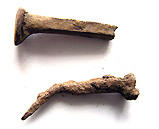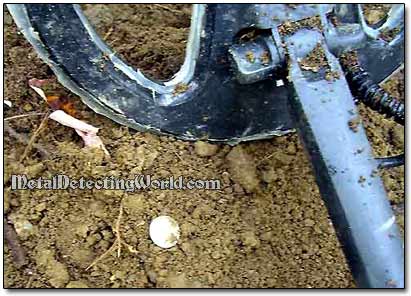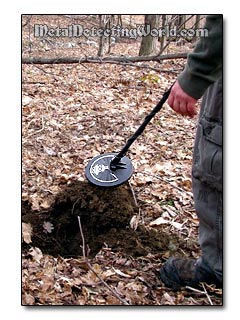How To Search a Former Homestead Site Located in Remote Area, page 2
Discrimination Settings and Search Coils Selection for Detecting Around Cellar Holes
DISCRIMINATION Settings
Using minimal or no Discrimination while getting a reasonably accurate ID of buried targets is the greatest advantage provided by metal detectors with Target ID systems. Knowing various audio pitch responses to a variety of both good and junk targets and their VDI (Visual Display Identification) readings gives a treasure hunter an extra edge in trashy areas.
For searching around old house foundations and cellar holes, using no Discrimination and listening to all signals would be an ideal technique.
Provided a High-Reactivity metal detector is used, this technique allows a treasure hunter to hear a high-pitched response of extremely short duration to a coin through multiple low-pitched responses to iron square nails.
The concentration of old square nails buried around the perimeter of the cellar hole is the biggest obstacle to successful recovering of valuable coins and relics. Using Discrimination to reject nails would compound the problem because of the masking effect created by the rejected nails lying in close proximity to a coin or relic.
If the detector's responses to nails are blocked by the Discriminate circuit, isolating good targets from iron junk can be very difficult, if not impossible, with metal detectors that operate with LOW Reactivity (Recovery Speed or Response Speed) and do not feature advanced Visual and Audio ID systems. When operated with Discrimination in areas highly contaminated with iron trash, metal detectors without visual target identification but with good target-separating abilities can give broken or clipped audio responses to partially masked coins.

In reality, using no Discrimination would drive anybody crazy because of the cacophony of audio responses to "zillions" of targets. That is why most people metal detect with Discrimination sometimes cranked up high, thus leaving many "goodies" behind, especially if they use large search coils.
If your detector can not effectively separate good target responses from the bad ones because it is not equipped with advanced Visual and Audio ID, and has a low Recovery Speed, I would suggest you to implement minimum Discrimination - only iron nails are rejected. And you should use a small search coil, 7 inches or less in diameter, if you want to minimize the masking of good signals by bad ones caused by long recovery time of your metal detector (low recovery speed).
And finally, here is one simple strategy for searching the sites of the former settlements or homesteads: as you gradually reduce an amount of both non-ferrous and ferrous targets in the ground, and you unintentionally break the Halo Effects of some rejected iron objects while actually digging up non-ferrous targets, you need to change some settings in your search program along with the Discrimination pattern accordingly.
In other words, it is not wise to "hammer" a good metal detecting site over and over using the same program settings and high Discrimination. For instance, when an inexperienced detectorist stops receiving good signals while hunting at any given metal detecting site, he/she thinks that the site has been depleted of all goodies, but in fact, the site has been just prepared for an upcoming skilled hunter who will sure reap the best fruits.
Please refer to my article "Metal Detector's Quieter Operation vs. Detecting More Deep Coins" (it is included in the "Search Programs for Minelab FBS Metal Detectors" section) for details on myths about Sensitivity, Discrimination and Detection Depth.
More details about Discrimination's negative effects on the detector's Audio and Visual Target ID are given in my article "Less Iron Discrimination Lets You Find More".
SEARCH COIL Selection
Obviously, the larger the search coil, the greater area of the ground the metal detector can cover in less time. Unfortunately, large search coils get responses from more junk targets and good targets simultaneously in addition to getting affected by more ground mineralization.

If you use a conventional wired metal detector, and most of them have a level of Recovery Speed (Reactivity) factory-preset at 1 (only two metal detectors being exceptions: Minelab CTX 3030 with Reactivity at 1.5, and XP Deus v3.2 with Reactivity ranging from 0 to 5(!)), follow these traditional rules:
- If the mineralization intensity is high and trash content is low, the 10-12 inch Double-D search coil should be used for optimum depth and coverage.
- If the mineralization intensity is low and the trash content is moderate, the 8 inch search coil will give you decent operating depth range (detecting range), target separation and ease of pinpointing.
- In case of high levels of both mineralization and junk, the 4-6 inch search coils will allow more accurate pinpointing and higher levels of sensitivity.
If you use a 21st-century totally wireless metal detector such as the XP Deus which allows for adjusting a level of Reactivity from 0 to 5, follow these rules:
- If the mineralization intensity is high and trash content is low, both an 11" x 13" elliptical DD search coil and an 11-inch Double-D coil should be used for optimum depth and ground coverage.
- If the mineralization intensity is low and the trash content is moderate, an 11-inch Double-D search coil will still give you excellent operating depth range, ground coverage and target separation.
- In case of high levels of both mineralization and junk, the 11-inch Double-D search coil will ...still give you decent operating depth range, ground coverage and target separation! (you may want to see my test report on the XP Deus 11-inch search coil - it is going to be published soon) All you have to do is to increase Reactivity to a reasonable level. In the most extreme cases, use the 9-inch stock coil.

In many cases, smaller search coils actually provide for a greater detecting range due to the higher level of sensitivity that can be used, higher response speed to very small targets, and maneuverability around natural obstacles such as dense vegetation, tree roots and crevices in proportion to larger coils.
With respect to scanning speed and overlap, the small search coil's diameter imposes a certain discipline on the metaldetectorist. Not to miss the small and deep buried targets, one has to scan the ground with 25% less speed, overlap at least 50% with every new scan and pay great attention to every minuscule "squeak".
When changing search coils during a hunt, always check and readjust Ground Balance (if it is not auto tuned), Sensitivity and Discrimination settings.
If your metal detector has a depth indicator, be sure to consider any differences in readings explored in Bench Testing (Air Testing). Many detectors have depth reading only calibrated to a stock search coil, so changes in the coil diameter and its configuration may give readings over or under actual target depth.